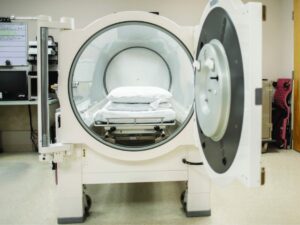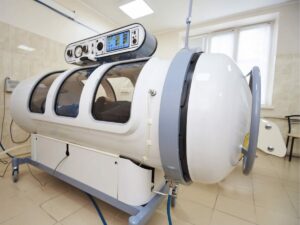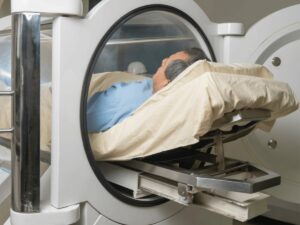Ever wondered how divers recover from the bends? Or how certain wounds can heal faster than expected? The secret lies in an innovative technology known as the hyperbaric chamber. This technology may not be widely recognized, but it is an essential tool that comes into play in many different scenarios, some of which may surprise you.
Hyperbaric chambers offer a wide range of applications, from assisting in medical treatments to enhancing athletic performance. In this comprehensive guide, we’ll delve into the science behind these chambers, their many applications, and the potential risks associated with them.
So, let’s dive in and explore this remarkable technology.
1. Understanding Hyperbaric Chambers
Hyperbaric chambers might sound like something out of a science fiction story, but they are very real, and their uses are varied and extensive. Here we delve into the specifics, the nitty-gritty details, and the integral components of these technological marvels.
What Are Hyperbaric Chambers?
Hyperbaric chambers are sealed environments in which atmospheric pressure can be precisely manipulated and substantially increased. In the simplest terms, they allow the occupant to take in significantly higher concentrations of oxygen than would be possible under ordinary conditions. These chambers come in varying sizes, designed to accommodate one or multiple individuals simultaneously.
How Do Hyperbaric Chambers Work?
The mechanism of a hyperbaric chamber relies on an elementary yet profound physical principle – Boyle’s Law, which states that the pressure and volume of a gas have an inverse relationship when the temperature is held constant. As the atmospheric pressure inside the chamber is increased, the density of the oxygen is elevated as well. Consequently, the human body can absorb more oxygen than it normally would.
Types of Hyperbaric Chambers
Hyperbaric chambers are typically classified into two categories: monoplace and multiplace. Monoplace chambers are designed for single-person use. Multiplace chambers, on the other hand, are larger and can accommodate several individuals at once, often used in hospitals or research facilities.
The table below provides an overview of the two main types of hyperbaric chambers, monoplace, and multiplace, highlighting their distinct features and applications in medical treatments and research, catering to different settings and patient needs.
| Hyperbaric Chamber Type |
Description |
| Monoplace Chamber |
Designed for single-person use, monoplace chambers are compact and suitable for private homes or clinics that require individual patient treatments. The chamber accommodates one person at a time and is often equipped with transparent walls to reduce feelings of confinement. Monoplace chambers are well-suited for hyperbaric oxygen therapy (HBOT) and wound healing treatments. |
| Multiplace Chamber |
Multiplace chambers are larger and can accommodate several individuals simultaneously. These chambers are often used in hospitals, medical centers, and research facilities, where medical staff can provide treatments to multiple patients at once. Multiplace chambers are capable of delivering hyperbaric oxygen therapy to multiple patients, and they are also used for conducting research and training medical personnel. |
Components of Hyperbaric Chambers
At OxygenArk, our hyperbaric chamber’s primary components include a pressure vessel, viewing windows, seats or beds for the occupants, built-in communication systems, and control panels for adjusting the pressure and oxygen levels. Depending on the chamber’s size and type, it may also include medical equipment, monitoring devices, and other auxiliary systems.
The Role of Oxygen in Hyperbaric Chambers
Oxygen plays a vital role in hyperbaric therapy. As the atmospheric pressure in the chamber is increased, so too is the concentration of oxygen in the air. This high-oxygen environment enables the body to absorb far more oxygen than it would under normal circumstances. This surplus oxygen can then be delivered to tissues and cells throughout the body, aiding in the healing and regeneration process.

2. Applications of Hyperbaric Chambers
Hyperbaric chambers have established their worth in a myriad of applications, many of which significantly contribute to human health and wellbeing. Here, we shed light on these various applications, from mainstream medical uses to experimental studies and non-medical applications.

Medical Applications
Hyperbaric chambers have proven to be integral components in numerous medical procedures, often making the difference between conventional and groundbreaking therapies.
Decompression Sickness in Divers
Hyperbaric chambers have become the standard in treating decompression sickness, commonly known as ‘the bends,’ a condition faced by divers who ascend too quickly. The rapid change in pressure causes nitrogen gas bubbles to form in the body’s tissues, leading to painful and potentially life-threatening symptoms. It helps to re-dissolve the bubbles back into the bloodstream, preventing further complications.
Supporting Immune Function
The enriched oxygen environment within hyperbaric chambers can bolster the immune system, making it an appealing option for individuals seeking to enhance their overall wellness and resistance to illness. A robust immune system is crucial for maintaining good health and effectively fighting off infections and diseases.
Treating Gas Embolisms
A similar application of hyperbaric therapy is in treating gas embolisms. These occur when gas bubbles obstruct blood vessels, hindering normal blood flow and potentially causing severe damage to organs. Hyperbaric chambers can compress these gas bubbles, restoring regular blood circulation and minimizing the risk of organ damage.
Carbon Monoxide Poisoning
The role of hyperbaric therapy in treating carbon monoxide poisoning is critical. In such cases, the patient’s blood is saturated with carbon monoxide, a poisonous gas, which prevents the transport of oxygen. By increasing the pressure and oxygen concentration in the chamber, the carbon monoxide can be rapidly displaced from the blood, accelerating the detoxification process.
Wound Healing and Skin Grafts
In wound healing and skin graft applications, hyperbaric chambers offer a unique advantage. For instance, the enhanced absorption of oxygen under hyperbaric conditions improves cellular function, promotes tissue growth, and boosts the immune system. According to R3 Hyperbarics, when tissue becomes hyperoxygenated through HBOT treatment, it becomes saturated with the oxygen known to stimulate healing.
Infectious Diseases and Radiation Injuries
Hyperbaric chambers have found a role in managing severe infections and radiation injuries as well. The high oxygen concentration under hyperbaric conditions can enhance the body’s ability to fight off infections, making it an effective tool for managing persistent bacterial and fungal diseases. In patients with radiation injuries, hyperbaric therapy can aid tissue repair, accelerate recovery, and alleviate symptoms.
Burns
Hyperbaric therapy has shown promise in aiding burn wound healing and reducing complications associated with severe burns. By increasing oxygen supply to damaged tissues, hyperbaric treatment enhances cell regeneration and supports the body’s natural healing process. Additionally, hyperbaric therapy can reduce the risk of infection and prevent tissue death, improving overall burn recovery outcomes.
Experimental Uses
Beyond traditional medical applications, hyperbaric chambers are being utilized in several experimental areas. With intriguing preliminary results, let’s delve into these innovative attempts to push the boundaries of hyperbaric therapy.

Autism and Other Neurological Conditions
One of the fascinating areas of hyperbaric research is its potential application in treating autism and other neurological conditions. Emerging studies suggest that the high-oxygen environment within the chamber may reduce brain inflammation, a common factor in various neurological disorders. This could potentially lead to improved cognitive function and behavioral responses in individuals with autism.
Cancer Treatment
The role of hyperbaric chambers in cancer treatment is an ongoing area of research. Early studies suggest that by increasing oxygen levels within cancerous tissues, hyperbaric therapy could potentially make these cells more susceptible to radiation or chemotherapy. In addition, the enhanced oxygen supply may inhibit the growth of certain types of cancer cells, offering a novel approach to cancer treatment.
Alzheimer’s
While still in the experimental stages, research suggests that hyperbaric therapy might hold potential for Alzheimer’s disease treatment. The increased oxygen supply to the brain could potentially improve brain function and cognitive abilities in individuals with Alzheimer’s. Further research is required to fully understand the efficacy of hyperbaric therapy in managing this complex neurological condition.
Lyme Disease
Some studies have explored the use of hyperbaric therapy as an adjunctive treatment for Lyme disease. The high-oxygen environment can enhance the body’s immune response, potentially aiding in combating Lyme disease bacteria and supporting overall recovery. However, more research is needed to establish the role of hyperbaric therapy as a definitive treatment for Lyme disease.
Stroke Recovery
Another promising experimental use of hyperbaric therapy involves stroke recovery. By promoting high levels of oxygen in the brain, hyperbaric treatment may potentially stimulate the regeneration of neurons and blood vessels damaged by a stroke. This could pave the way for improved functional recovery and a better quality of life for stroke survivors, marking a significant stride in stroke rehabilitation.
Non-Medical Applications
Apart from the medical realm, hyperbaric chambers have been explored for various non-medical applications. Let’s embark on a journey to discover the broad spectrum of uses that stretch beyond the traditional medical paradigm.
Athletic Recovery and Performance Enhancement
In the world of sports, hyperbaric chambers are gaining popularity for their role in accelerating recovery and enhancing performance. The enriched oxygen environment within the chamber aids in reducing muscle fatigue, speeding up the healing process of injuries, and enhancing the body’s ability to build strength and endurance.
Cognitive Performance and Mental Clarity
Hyperbaric therapy has shown promising effects on cognitive function and mental clarity. The increased oxygen levels delivered during the treatment can enhance brain activity, improve focus, and boost overall mental performance. Individuals seeking to optimize their cognitive abilities and productivity have turned to hyperbaric chambers as a non-invasive and drug-free means to achieve mental acuity.
Anti-Aging and Wellness Use
Hyperbaric therapy has also piqued interest in the realm of anti-aging and wellness. For instance, the enhanced oxygen absorption can stimulate the production of collagen, which plays a critical role in maintaining skin elasticity and reducing the visible signs of aging. According to Inter Mountain Health Care, the increase in pressure can also reduce swelling, which in turn, increases blood flow.
Potential Use in Space Travel
Another intriguing non-medical application of hyperbaric chambers is their potential use in space travel. As astronauts are exposed to reduced atmospheric pressure in space, hyperbaric therapy could help acclimatize their bodies to these conditions and reduce the risk of decompression sickness during extravehicular activities. This could play a vital role in the safety and success of future space missions.
Supporting Immune Function
The enriched oxygen environment within hyperbaric chambers can bolster the immune system, making it an appealing option for individuals seeking to enhance their overall wellness and resistance to illness. Regular hyperbaric therapy may help to reduce the occurrence and severity of common illnesses, and it can be particularly beneficial for individuals with compromised immune systems or those prone to frequent infections.
3. Risks and Side Effects of Hyperbaric Therapy
Though hyperbaric therapy presents a myriad of benefits, it’s essential to acknowledge the potential risks and side effects associated with it. We present a deeper dive into the potential complications and precautions to consider when using hyperbaric chambers.
Pressure-Related Complications
Hyperbaric therapy, while largely safe, can lead to complications if not appropriately administered. The rapid pressure changes within the chamber can cause ear or sinus pain, particularly for individuals who have difficulty equalizing their ear pressure. In severe cases, these pressure changes can lead to a perforated eardrum, which might necessitate surgical intervention.
Oxygen Toxicity
Exposure to high concentrations of oxygen during hyperbaric therapy can lead to oxygen toxicity. This condition, although rare, can cause lung damage and in severe instances, provoke seizures. However, this risk is typically low given the controlled setting of the therapy and the diligent monitoring of patients during treatment.
Claustrophobia Concerns
Being inside a hyperbaric chamber may trigger feelings of claustrophobia for some individuals. The enclosed nature of the chamber, combined with the duration of the therapy, can be challenging for those who are uncomfortable in confined spaces. At OxygenArk, steps are often taken to mitigate this concern, including the use of transparent chambers and providing communication channels during treatment.
Vision Alterations
Among the potential side effects of hyperbaric therapy, vision alterations can be a cause for concern. Hyperbaric oxygen therapy involves exposing the body to high levels of oxygen, which can induce temporary changes in the shape of the eye’s lens. These changes may lead to a condition known as myopia or nearsightedness, making it difficult for patients to see distant objects clearly.
Risk of Fire
One of the rare but significant risks associated with hyperbaric therapy is the potential for fire within the hyperbaric chamber. The therapy involves an enriched oxygen environment, which significantly increases the flammability of materials that are normally non-combustible. While the risk is extremely low, stringent safety protocols are in place to ensure patient safety during hyperbaric treatment.
Barotrauma and Decompression Sickness
There is a risk of barotrauma and decompression sickness, especially if proper safety protocols are not followed during treatment. Barotrauma refers to tissue damage caused by rapid changes in pressure, particularly affecting the ears and sinuses. Decompression sickness, also known as “the bends,” can occur if a patient ascends too quickly after hyperbaric treatment.
Dive Deeper Into Our Resources
Looking for more diverse product options? Browse through our handpicked selections:
For some insightful reads, we’ve curated a list of recommended articles just for you:
Still haven’t found what you’re looking for? Don’t hesitate to contact us. We’re available around the clock to assist you.
4. Conclusion
Hyperbaric chambers have proven themselves as versatile tools with a broad spectrum of applications, reaching far beyond their initial medical uses. For those considering incorporating hyperbaric therapy into their health or wellness regimen, it is crucial to consult with qualified healthcare professionals who can tailor treatments to individual needs and ensure a safe and effective experience.
OxygenArk stands as a leading manufacturer known for its cutting-edge technology, commitment to safety, and dedication to innovation. Explore the vast potential of hyperbaric therapy and discover how it can enhance your well-being. Contact us today to learn more about the advanced hyperbaric chambers by OxygenArk.



